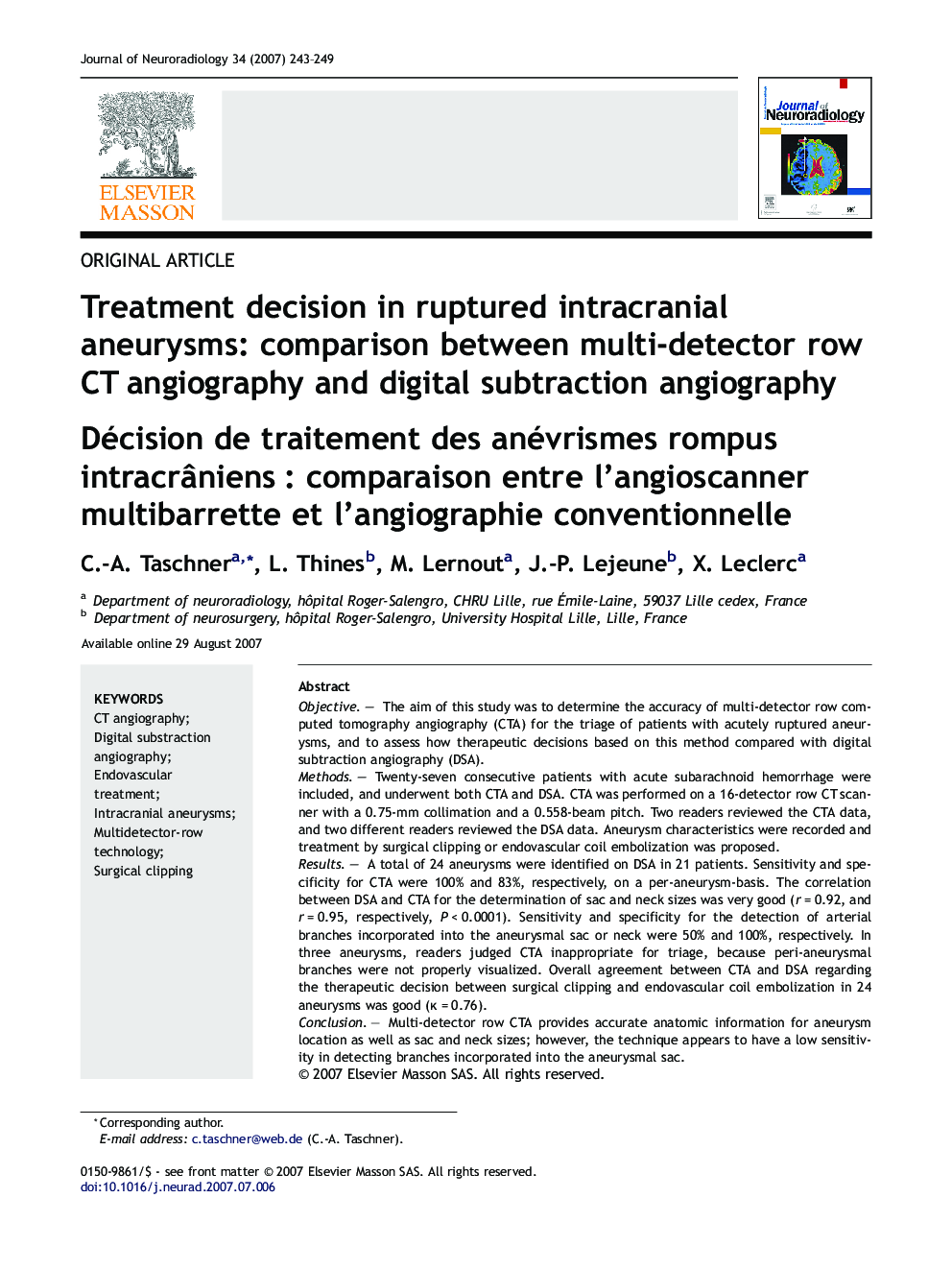| کد مقاله | کد نشریه | سال انتشار | مقاله انگلیسی | نسخه تمام متن |
|---|---|---|---|---|
| 4234604 | 1282811 | 2007 | 7 صفحه PDF | دانلود رایگان |

ObjectiveThe aim of this study was to determine the accuracy of multi-detector row computed tomography angiography (CTA) for the triage of patients with acutely ruptured aneurysms, and to assess how therapeutic decisions based on this method compared with digital subtraction angiography (DSA).MethodsTwenty-seven consecutive patients with acute subarachnoid hemorrhage were included, and underwent both CTA and DSA. CTA was performed on a 16-detector row CT scanner with a 0.75-mm collimation and a 0.558-beam pitch. Two readers reviewed the CTA data, and two different readers reviewed the DSA data. Aneurysm characteristics were recorded and treatment by surgical clipping or endovascular coil embolization was proposed.ResultsA total of 24 aneurysms were identified on DSA in 21 patients. Sensitivity and specificity for CTA were 100% and 83%, respectively, on a per-aneurysm-basis. The correlation between DSA and CTA for the determination of sac and neck sizes was very good (r = 0.92, and r = 0.95, respectively, P < 0.0001). Sensitivity and specificity for the detection of arterial branches incorporated into the aneurysmal sac or neck were 50% and 100%, respectively. In three aneurysms, readers judged CTA inappropriate for triage, because peri-aneurysmal branches were not properly visualized. Overall agreement between CTA and DSA regarding the therapeutic decision between surgical clipping and endovascular coil embolization in 24 aneurysms was good (κ = 0.76).ConclusionMulti-detector row CTA provides accurate anatomic information for aneurysm location as well as sac and neck sizes; however, the technique appears to have a low sensitivity in detecting branches incorporated into the aneurysmal sac.
RésuméObjectifLe but de ce travail était de déterminer la précision de l'angioscanner multibarrette pour le triage des patients présentant un anévrisme rompu intracrânien et d'étudier la précision de cette méthode pour la décision thérapeutique comparée à l'angiographie conventionnelle.Matériel et méthodeVingt-sept patients consécutifs admis pour une hémorragie sous-arachnoïdienne ont été inclus et ont bénéficié d'un angioscanner et d'une angiographie conventionnelle. Les examens scanographiques étaient réalisés sur un scanner 16 barrettes avec des coupes de 0,75 mm et un pitch de 0,558. Deux lecteurs ont analysé les données du scanner et deux autres lecteurs ont analysé les angiographies conventionnelles. Les caractéristiques de l'anévrisme étaient notées, et un traitement par chirurgie ou par embolisation était proposé.RésultatsUn total de 24 anévrismes chez 21 patients était identifié en angiographie conventionnelle. La sensibilité et la spécificité de l'angioscanner pour la détection d'un anévrisme étaient de 100 et 83 % respectivement. La corrélation entre l'angioscanner et l'angiographie conventionnelle pour la détermination de la taille du sac et du collet était très bonne (r = 0,92, and r = 0,95 respectively, p < 0,0001). La sensibilité et la spécificité de l'angioscanner pour la détection d'une branche artérielle incorporée au sac ou au collet de l'anévrisme étaient 50 et 100 % respectivement. Pour trois anévrismes, les lecteurs ont jugé l'angioscanner inapproprié pour le triage avant traitement, car les branches artérielles périanévrysmales n'étaient pas visualisées correctement. La concordance globale entre angioscanner et angiographie conventionnelle pour la décision thérapeutique entre chirurgie et embolisation était jugée bonne pour 24 anévrismes.ConclusionLe scanner multibarrette fournit des informations anatomiques précises tant pour la localisation de l'anévrisme que pour la mesure de sac et du collet. Cependant, cette technique semble avoir une sensibilité faible pour la détection des branches artérielles incorporées au sac anévrysmal.
Journal: Journal of Neuroradiology - Volume 34, Issue 4, October 2007, Pages 243–249